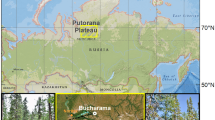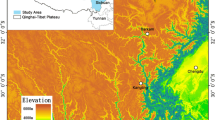Abstract
Purpose
Despite the ancillary knowledge that soil N is chiefly retained as soil organic matter, little is known about how it is affected by other soil and environmental factors, especially in the tropics. In this study, we performed a comprehensive survey of soils under native vegetation in Minas Gerais, Brazil, aiming to (a) measure soil Kjeldahl-N concentrations to a 1-m depth, (b) identify the main affecting factors of soil N retention, and (c) predict N through soil profile based on organic C (SOC) and its main conditioning factors.
Materials and methods
Soils under 36 fragments of native forest and savanna were sampled at five depths (0–10, 10–20, 20–40, 40–60, and 60–100 cm) and characterized by physical and chemical analyses, including total N determined by the micro-Kjeldahl method. Single and multivariate regressions were used to predict N concentrations based on soil properties and climatic factors.
Results and discussion
The average N concentrations ranged between 0.12 and 7.54 g kg−1, decreasing with depth, and can be predicted using SOC concentrations (R 2 = 0.86). Multivariate regressions using more input data, namely texture, cation exchange capacity (CEC), and altitude increased slightly R 2 values (0.68–0.90) for separate soil depths, but not for the whole dataset (R 2 = 0.85).
Conclusions
We demonstrated that N can be adequately predicted based on SOC concentrations, for any depth and forest type. The implications of the stable SOC/N relation and their coupled cycles and the environmental factors affecting N retention in Brazilian weathered soils are further discussed.






Similar content being viewed by others
References
Alvarez R, Lavado RS (1998) Climate, organic matter and clay content relationships in the Pampa Chaco soils, Argentina. Geoderma 83:127–141
Arrouays D, Pelissier P (1994) Modeling carbon storage profiles in temperate forest humic loamy soil of France. Soil Sci 157:185–192
Baldock JA, Nelson PN (2000) Soil organic matter. In: Summer M (ed) Handbook of soil science. CRC Press, Boca Raton
Barry RG, Chorley RJ (2003) Atmosphere, weather and climate. 8th ed. Routledge, London
Benites VM, Machado PLOA, Fidalgo ECC, Coelho MR, Madari BE (2007) Pedotransfer functions for estimating soil bulk density from existing soil survey reports in Brazil. Geoderma 139:90–97
Berhongaray G et al (2013) Land use effects on soil carbon in the Argentine Pampas. Geoderma 192:97–110
Bouyoucos GJ (1962) Hydrometer method improved for making particle size analyses of soils. Agron J 54:464–465
Brady NC, Weil RR (2004) The nature and properties of soils. Prentice-Hall, New York
Brasil (1992) Ministério da Agricultura e Reforma Agrária. Departamento Nacional de Meteorologia. Normas Climatológicas: 1961–1990. Mapa, Brasília
Bremner JM (1996) Nitrogen total. In: Sparks DL (ed) Methods of soil analysis, part 3: chemical methods. Soil Science Society of America, Madison
Calazans SOL (2014) Nitrogênio do solo sob vegetação native em Minas Gerais: teores, estoques e modelagem. UFLA, Lavras
Callesen I et al (2003) Soil carbon in Nordic well-drained forest soils relationships with climate and texture class. Glob Change Biol 9:358–370
Camargo FAO, Gianello C, Vidor C (1997) Potencial de mineralização do nitrogênio em solos do Rio Grande do Sul. Revista Brasileira de Ciência do Solo 21:575–580
Cameron KC, DI HJ, Moir JL (2013) Nitrogen losses from the soil/plant system: a review. Annal Appl Biol 162:145–173
Cantarella H, Quaggio JÁ, Raij B (2001) Determinação da matéria orgânica. In: Raij B, Andrade JC, Cantarella H, Quaggio JA (eds) Análise química para avaliação da fertilidade de solos tropicais. Instituto Agronômico, Campinas, pp. 173–180
Cardoso EL et al (2010) Estoques de carbono e nitrogênio em solo sob florestas nativas e pastagens no bioma Pantanal. Pesq Agrop Brasileira 45:1028–1035
Cole CV et al (1993) Analysis of agroecosystem carbon pools. Water Air Soil Pollut 70:357–371
Côté L et al (2000) Dynamics of carbon and nitrogen mineralization in relation to stand type, stand age and soil texture in the boreal mixedwood. Soil Biol Biochem 32:1079–1090
D’Andréa AF et al (2004) Estoque de carbono e nitrogênio e formas de nitrogênio mineral em um solo submetido a diferentes sistemas de manejo. Pesq Agrop Brasileira 39:179–186
Feller C, Albrecht A, Tessier D (1996) Aggregation and organic matter storage in kaolinitic and smectitic tropical soils. In: Carter MR, Stewart BA (eds) Structure and organic matter storage in agricultural soils. Lewis, Boca Raton
Fornara DA, Tilman D (2008) Plant functional composition influences rates of soil carbon and nitrogen accumulation. J Ecol 96:314–322
Garten Junior CT et al (1999) Forest soil carbon inventories and dynamics along an elevation gradient in the southern Appalachian Mountains. Biogeochemistry 45:115–145
Giardina CP et al (2001) Tree species and soil textural controls on carbon and nitrogen mineralization rates. Soil Sci Soc Am J 65:1272–1279
Glendining MJ et al (2011) Pedotransfer functions for estimating total soil nitrogen up to the global scale. Eur J Soil Sci 62:13–22
Grossman RB, Reinsch TG (2002) Bulk density and linear extensibility. In: Dane JH, Topp C (eds) Methods of soil analysis: physical methods. Soil Science Society of America, Madison
Helling CS et al (1964) Contribution of Organic Matter and Clay to Soil Cation-Exchange Capacity as Affected by the pH of the Saturating Solution1. Soil Sci Soc Am J 28:517--520
Jenny H (1941) Factors of soil formation: a system of quantitative pedology. McGraw-Hill, New York
Jobbágy EG, Jackson RB (2000) The vertical distribution of soil organic carbon and its relation to climate and vegetation. J Appl Ecol 10:423–436
Kirschbaum MUF (1995) The temperature dependence of soil organic matter decomposition, and the effect of global warming on soil organic C storage. Soil Biology and Bioch 27:753--760
Knops JMH, Bradley KL (2009) Soil carbon and nitrogen accumulation and vertical distribution across a 74-year chronosequence. Soil Sci Soc Am J 73:2096–2104
Lemenith M, Itanna F (2004) Soil carbon stocks and turnovers in various vegetation type and arable lands along an elevation gradient in southern Ethiopia. Geoderma 123:177–188
Maia SMF et al (2008) Nitrogen fractions in a Luvisol under agroforestry and conventional systems in the semi-arid zone of Ceará, Brazil. Revista Brasileira de Ciência do Solo 32:381–392
Maia SM et al (2009) Effect of grassland management on soil carbon sequestration in Rondônia and Mato Grosso states, Brazil. Geoderma 149:84–91
Mendonça ES, Rowell DL (1996) Mineral and organic fractions of two Oxisols and their influence on effective cation-exchange capacity. Soil Sci Soc Am J 60:1888–1892
Nelson DW, Sommers LE (1996) Total carbon, organic carbon, and organic matter. In: Black CA (ed.) Methods of soil analysis. Part 3. Chemical methods. Soil Science of America and American Society of Agronomy, Madison, pp 961–1010
Oades JM (1988) The retention of organic matter in soils. Biogeochemistry 5:35–70
Oksanen J, Guillaume Blanchet F, Kindt R, Legendre P, Minchin PR, O’Hara RB, Simpson GV, Solymos P, Henry M, Stevens H, Wagner H (2015) Vegan: community ecology package. R package version 2:2–1 http://CRAN.R-project.org/package=vegan
Post WM et al (1985) Global patterns of soil nitrogen storage. Nature 317:613–616
Quideau SA et al (2001) A direct link between forest vegetation type and soil organic matter composition. Geoderma 104:41–60
Raij B, Andrade JC, Cantarella H, Quaggio JA (2001) Análise química para avaliação da fertilidade de solos tropicais. Instituto Agronômico, Campinas
Rangel OJP et al (2008) Carbono orgânico e nitrogênio total do solo e suas relações com os espaçamentos de plantio de cafeeiro. Revista Brasileira de Ciência do Solo 32:2051–2059
Rashidi M, Seilsepour M (2009) Modeling of soil nitrogen based on soil organic carbon. ARPN Journal of Agricultural and Biological Science 4:1–5
Reich PB et al (1997) Nitrogen mineralization and productivity in 50 hardwood and conifer stands on diverse soils. Ecology 78:335–347
Schlesinger WH (1997) Biogeochemistry: an analysis of global change. Academic, London
Scolforo HF, Scolforo JRS, Mello CR, Mello JM, Ferraz Filho AC (2015) Spatial distribution of aboveground carbon stock of the arboreal vegetation in Brazilian biomes of savanna, Atlantic forest and semi-arid woodland. PLoS One 10:1–20
Seybold CA et al (2005) Predicting Cation Exchange Capacity for Soil Survey Using Linear Models. Soil Sci. Soc. Am J 69:856--863
Silva CA, Vale FR, Guilherme LRG (1994) Efeito da calagem na mineralização do nitrogênio em solos de Minas Gerais. Revista Brasileira de Ciência do Solo 18:471–476
Silva CA, Vale FR, Fernandes LA (1999) Nitrificação em amostras de onze solos de Minas Gerais sob influência da correção da acidez. Revista Ceres 46:457–470
Silva JE et al (2004) Carbon storage in clayey Oxisol cultivated pastures in the “Cerrado” region, Brazil. Agr Ecosyst Environ, Amsterdam 103:357–363
Six J et al (2002) Measuring and understanding carbon storage in afforested soils by physical fractionation. Soil Sci Soc Am J 66:1981–1987
Skorupa ALA et al (2012) Propriedades de solos sob vegetação nativa em Minas Gerais: distribuição por fitofisionomia, hidrografia e variabilidade espacial. Revista Brasileira de Ciência do Solo 36:11–22
Sparks DL et al (eds) (1996) Methods of soil analysis: chemical methods. Soil Science Society of America, Madison
Stevenson FJ (1994) Humus chemistry: genesis, composition, reactions, 2nd edn. John Wiley, New York
Vejre H et al (2003) Carbon and nitrogen in Danish forest soils: contents and distribution determined by soil order. Soil Sci Soc Am J 67:335–343
Wang SQ et al (2004) Vertical distribution of soil organic carbon in China. J Environ Manag 33:200–209
Wang S et al (2005) Gradient distribution of soil nitrogen and its response to climate change along the Northeast China Transect. Chin J Appl Ecol 16:279–283
Wu HB, Guo ZT, Peng CH (2003) Land-use induced changes of organic carbon storage in soils of China. Glob Change Biol 9:305–315
Xu RI, Prentice IC (2008) Terrestrial nitrogen cycle simulation with a dynamic global vegetation model. Glob Change Biol 14:1745–1764
Yang YH et al (2010) Vertical patterns of soil carbon, nitrogen and carbon: nitrogen stoichiometry in Tibetan grasslands. Biogeosci Discuss 7:1–24
Zinn YL, Lal R, Resck DVS (2005) Texture and organic carbon relations described by a profile pedotransfer function for Brazilian Cerrado soils. Geoderma 127:168–173
Acknowledgments
This research was funded by the CNPq (process 308592/2011-5), Fapemig (process CAG - APQ 00291-11), and Cemig. The authors are grateful to the staff of the Department of Forest Science (Lemaf), Federal University of Lavras, involved in field sampling, processing, preparation and some of laboratory analysis of soil samples. We thank student Henrique J. G. M. Maluf (Federal University of Lavras) for the help with the principal component analysis.
Author information
Authors and Affiliations
Corresponding author
Additional information
Responsible editor: Heike Knicker
Rights and permissions
About this article
Cite this article
Calazans, S.O.L., Morais, V.A., Scolforo, J.R. et al. Soil organic carbon as a key predictor of N in forest soils of Brazil. J Soils Sediments 18, 1242–1251 (2018). https://doi.org/10.1007/s11368-016-1557-4
Received:
Accepted:
Published:
Issue Date:
DOI: https://doi.org/10.1007/s11368-016-1557-4




